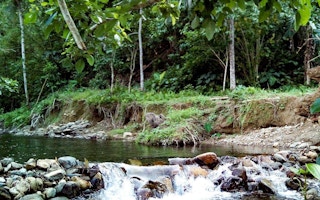Activists and local government officials in the central Philippines have lashed out at a recently announced plan to build a hydroelectric plant overlapping with a national park that’s home to rare and threatened species.
Strategic Power Development Corporation (SPDC), a subsidiary of Philippine mega conglomerate San Miguel Corporation, announced on July 13 its intention to build the $500 million, 300-megawatt pump-storage hydro facility in Malay municipality on the island of Panay. The project would include the construction of two dams and reservoirs, 9.6 kilometers (6 miles) of new roads, and the upgrade of 1.8 km (1.1 mi) of existing roads.
According to SPDC, the planned project near the confluence of the Nabaoy and Imbaroto rivers would consist of a 70-meter (230-foot) lower dam on the Naboay, with a 10.2-million-cubic-meter (2.7-billion-gallon) reservoir; and a 74 m (243 ft) upper dam with a 4.55-million-m3 (1.2-billion-gallon) reservoir extending to the Imbaroto. The company says the plant will provide energy to the regional grid to meet current and future peak demand, will support the local economy, and is part of President Rodrigo Duterte’s 2017-2040 Philippine Energy Plan.
Overall, the company says the complex would cover 122.7 hectares (303.2 acres), including 97.9 hectares (241.9 acres) of forest, of which 24.9 hectares (61.5 acres) are nominally protected land within Northwest Panay Peninsula Natural Park.
Significant biodiversity hotspot
Northwest Panay Peninsula Natural Park, which spans 12,009 hectares (29,676 acres) in the provinces of Aklan and Antique, was established in 2002 via a presidential proclamation. Home to critically endangered Visayan warty pigs (Sus cebifrons) and writhed-billed hornbills (Rhabdotorrhinus waldeni), as well as endangered Visayan hornbills (Penelopides panini), it has been locally recognized as a significant biodiversity hotspot since the 1990s.
The park holds some of the last remaining stands of primary lowland rainforest in the central Philippines, and serves as a key watershed providing potable water to Panay and neighbouring islands.
Activists say the hydropower project puts water supplies for local communities at risk.
“The Nabaoy River is the lone source of potable water to nearby Boracay Island and to the residents of Malay,” said Ritchel Cahilig of the Aklan Trekkers Group. Boracay Island, separated from the park by a narrow strait, is a prime beach destination, recording 2 million tourist arrivals in 2019.
“I wonder how will they supply water to the residents especially during construction phase. During construction phase, for sure, large vehicles will be damaging the forest and the company seems do not have a clear alternative on how to restore what has been damaged,” Cahilig said.
The natural park is also home to a community of Indigenous Malay Ati people, who fish in the Nabaoy River and rely on the forests for sustenance.
Activists have also questioned the need for additional electrical capacity in the area. Citing reports from the National Grid Corporation of the Philippines, Melvin Purzuelo of the Green Forum-Western Visayas noted that from July 20-26, Panay Island’s average daily electricity consumption ranged from 345-364 MW, against existing capacity of 480 MW.
“It is clear now that a huge power supply is not needed at this time especially that the world is going through the Covid-19 pandemic,” Purzuelo said during a recent webinar.
Loss of local government support
SPDC’s proposal still requires approval from local governments and the Philippine Department of Environment and Natural Resources (DENR).
“The Malay [municipal government] have set a coordination meeting with the SPDC supposedly last August 2 to clarify issues involving the project but [the meeting] has been cancelled because of the Covid-19 pandemic,” Purzuelo said.
Local officials have distanced themselves from endorsing the proposal. In a phone interview, acting Malay Mayor Floribar Bautista said the SPDC had not approached him to discuss the details of the project since he assumed his post in July 2018.
“What I know is the project was endorsed by the previous administration. When I checked the documents, it’s lacking. It seems the project may have [been] railroaded. I could not endorse the project at this time since I do not know how the project would affect our town. All they have to do is to convince me if the hydro dam project is worth it,” he said.
The village of Nabaoy is also reportedly set to cancel its previous endorsement of the project, activists say. No official cancellation had been issued as of the time this article was published; but just as in the case of the Malay municipal government, the previous leadership of Nabaoy village had endorsed the project in the early months of 2018.
Without approval from the current local governments, the project can only push through with special permission from the DENR.
Rebecca Tandug, of the Philippine Initiative for Environmental Conservation (Philincon), said her organization will maintain its opposition to the project and attempt to engage with SPDC. Eventually, she said, she hopes the company will decide to cancel the proposed plant.
This story was published with permission from Mongabay.com.










